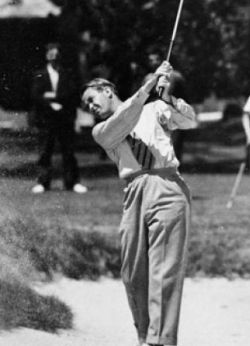May 7, 2022
The Case for the Short Hitter
 In golf and life there is always someone better. That doesn't mean that you quit and stop trying. The beauty of golf is there are many ways to accomplish your goals. Most times, short and straight beats long and crooked. The world of professional golf is filled with short hitters that won majors and collected a lot of money through their careers. Paul Runyan (pictured on left), Jerry Barber, Dave Stockton, Corey Pavin, Tom Kite, Jim Furyk are just a few from the past decades that won major championships and excelled despite not great length off the tee.
In golf and life there is always someone better. That doesn't mean that you quit and stop trying. The beauty of golf is there are many ways to accomplish your goals. Most times, short and straight beats long and crooked. The world of professional golf is filled with short hitters that won majors and collected a lot of money through their careers. Paul Runyan (pictured on left), Jerry Barber, Dave Stockton, Corey Pavin, Tom Kite, Jim Furyk are just a few from the past decades that won major championships and excelled despite not great length off the tee.
Today's PGA superstars are seemingly obsessed with "longer the better". The "hit it long and gouge it out of the heavy rough" approach has worked well in most cases, but they have their best weeks when they are long and also straight. Phil Mickelson didn't win his first major until he throttled back his driver and hit more 3 woods for position. Rory McIlroy is the best long and straight driver in the game today. When he is on, he can literally destroy a golf course and make it a "pitch and putt" course. Unfortunately, he hasn't mastered the finesse wedges shots from 100 yards and in that would make him almost unbeatable. All the players that I listed above had one trait in common in their prime. They were either the best of near the best in wedge shot accuracy and putting.
Paul Runyan was 5'4" and weighed 108 lbs. In 1933, he won nine times and was leading money winner in 1934 with seven wins and the PGA Championship. His second PGA Championship was in 1938 against Sam Snead in a match that no one thought he had a chance to win, because Snead consistently outdrove Paul by as much as eighty yards! Paul won the championship match 8 and 7. At age 72, he played in the Bob Hope Desert Classic, where one of the rounds was played at La Quinta Country Club. At that age he was even shorter in distance off the tee to the extent that the only greens he could reach in regulation were two of the par three's. That day, he hit one green and shot a two over par 74. He two putted the one hole he hit in regulation, which meant he got the ball "up and down" 15 times out of 17 opportunities with 21 putts. That's beyond brilliant!
Jerry Barber putted and chipped his way to the 1961 PGA Championship by making three putts on the last three holes of 20 feet, 40 feet and 60 feet to tie for the championship and proceed to do the same wizardry around the greens the next day in the 18 hole play-off to a stunned Don January. When you give up a significant amount of yardage off the tee, you have to make up for it in other areas. Most short hitters like the ones I have mentioned didn't go on weight lifting programs and change their swings to gain a few more yards, but they worked harder on the scoring clubs that made the most difference.
Next week the PGA Championship will be played at Southern Hills CC in Tulsa, Oklahoma. Dave Stockton won his first of two major championships there on what most consider a long course. Dave was brilliant around the greens to fend off Ray Floyd and Arnold Palmer, who were much longer, by two strokes. The person who will hold the trophy this following week will undoubtedly strike the ball well, but he will really win because of his ability to scramble and make putts.
Long is good, but there's a place for "slow and steady wins the race". Watch out next week for those players that can combine strength with finesse. People to watch: Collin Morikawa ranked 94th in driving distance, Cameron Smith (122nd), Daniel Berger (178th), and Kevin Na (182nd). Also lookout for those with reasonable length but outstanding short games: Xander Schauffele (36th) and Jordan Spieth (39th). For us mere mortals, remember it's nice to gain a few yards off the tee, but if you improve your shots inside 100 yards it will have a much more dramatic influence on your score.



